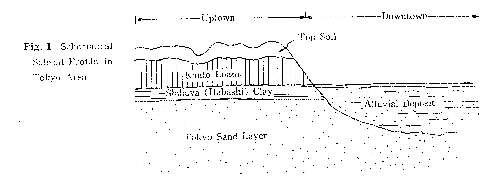|
■建築研究報告 |
|
Measured Values of Coefficient of Subgrade Reaction Yorihiko OHSAKI 建築研究報告 No.21, 1957 建設省建築研究所 |
| <概要> |
| In the previous paper1), reports and papers published up to the present time
by many scientists in the field of geology were reviewed and summarized to present
the formation and the geological history of major subsoil layers in Tokyo City
in the interest of foundation engineers.
In the same paper, data of several hundreds of borings carried out for the future extension of Tokyo subway networks were analyzed in detail, and geotechnical properties of those subsoils were also shown by summarizing soil mechanics test results made in the writer's laboratory with respect to a large number of undisturbed samples. A typical subsoil profile in Tokyo area disclosed by these investigations is as schematically shown in Fig. 1. Namely, the subsoil of Uptown Tokyo consists of three major diluvial strata, Kanto-Lome, Shibuya (or Itabashi) Clay and Tokyo Sand Layer, while in Downtown Tokyo these strata are eroded and thick alluvial sediment is deposited instead thereof. Kanto-Loam is the deposit of volcanic ash erupted from Mt. Fuji and Mt. Hakone about fifty miles south-west of Tokyo, and is commonly relied upon as the bearing base for small to medium buildings. Tokyo Sand Layer is very dense and hard deposit of fine to medium sand, and usually contains layers of gravel in its interior. Tokyo Sand Layer is widely used as the bearing base for large scale buildings. Few buildings can be found in Tokyo area, which are rested on Shibuya or Itabashi Clay stratum. The nature of alluvial deposit in Downtown Tokyo is quite different at different spots and at different elevations, varying from silty sand to cohesive clay. The writer has compiled, by the courtesy of Bureau of Building Construction, Tokyo Metropolitan Government, the records of loading tests carried out recently at about 190 building sites in Tokyo area. In this paper, values of so-called coefficient of subgrade reaction are obtained from these test records, and they are treated statistically to find out in what range usual values of the coefficient for each of these subsoil layers are. It is also discussed in the latter part of this paper whether the application of so-called Winkler's theory of subgrade reaction to the practical design of footings may be warranted or not, in which stiffnesses of both the footing and the subgrade are taken into account. |
 |

